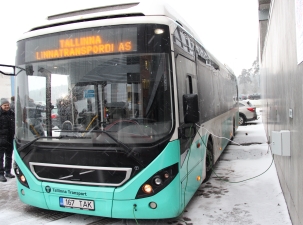During the pilot project, Eesti Energia shall develop a smart charging solution that is able to control charging according to electricity prices and loads.
Within the framework of the pilot project, Tallinn bus routes will be selected, for which ten electric buses are planned to be purchased in order to prepare for the bigger deployment of electricity transport in Tallinn.
“In energy production, Estonia has been able to significantly reduce CO2 emissions over the last decade, but there has not been much progress in terms of carbon emissions in the transport sector,” said Margus Vals, Member of the Management Board of Eesti Energia, when explaining the reasons that encouraged companies to cooperate.
According to Deniss Boroditš, Chairman of the Management Board of Tallinna Linnatranspordi AS, today electric buses are a tangible way to make the transport sector more environmentally friendly. “As public transport needs to be more and more electrified in the future in terms of buses as well, sharing the competencies of the two companies is a natural way of doing things,” said Boroditš.
“In Eesti Energia, we can help improve the urban environment with our knowledge and expertise to develop a smart charging solution for electric buses that can choose the most favourable electricity consumption time for charging bus batteries both in terms of economy and in terms of efficient network load sharing, so that every morning the buses are ready to serve passengers again,” said Margus Vals.
According to Boroditš, the company has set a goal that by 2035, all buses that serve passengers on the streets of Tallinn will be powered by electricity. "To do this, we need to raise our competence in the field of electric buses right now in order to be ready for adding increasingly reliable electric buses to our bus fleet," said Boroditš.
According to Margus Vals, the objective of Eesti Energia is to be ready for a general increase in the number of electric cars. “The common understanding is that the growth of electricity transport is creating a too heavy burden for the electricity network. In our opinion, such a burden may not become a problem, as electric vehicles can also be considered as devices to store energy. The idea of using storage technology in the energy sector lies in the fact that energy is saved when the price is cheaper, and used when it is more expensive. The stored energy can also be redirected to the grid to help disperse the electricity network load, increase the use of renewable energy, and ensure the stability of the grid when Estonia is desynchronised from the Russian electricity system. Thus, in conclusion, we believe that electric cars can be deployed as part of the network,” said Vals.
In addition, according to Vals, there is a plan to develop high-quality services for the owners of electric vehicles. “For us, co-operation with Tallinna Linnatranspordi AS is a great opportunity to create new solutions to provide a convenient and smart system for electric car owners alongside buses, sharing the load between all electrical equipment without having to pay more for electricity,” said Vals.
Statistics show that the introduction of electric cars in the world is increasing as the prices of electric cars are becoming closer and closer to the prices of conventional cars. Estimates show that by 2040, 55 percent of the new cars sold worldwide will be electric.
02 Января 2026 | пятница | 22:44


